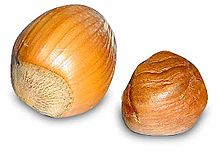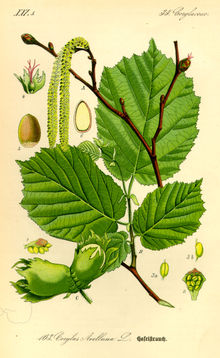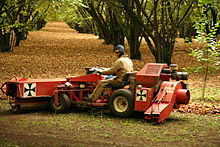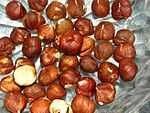- Hazelnut
-
For the tree, see Corylus avellana.
Nuts, hazelnuts or filberts Hazelnuts, with shell (left), without shell (right) Nutritional value per serving Serving size 100g Energy 2,629 kJ (628 kcal) Carbohydrates 16.7 - Starch 0.48 - Sugars 4.34 - Dietary fiber 11 Fat 60.75 - saturated 4.464 - monounsaturated 45.652 - polyunsaturated 7.92 Protein 14.95 Water 5.31 Vitamin A equiv. 1 μg (0%) Vitamin A 20 IU - beta-carotene 11 μg (0%) - lutein and zeaxanthin 92 μg Thiamine (vit. B1) 0.643 mg (56%) Riboflavin (vit. B2) 0.113 mg (9%) Niacin (vit. B3) 1.8 mg (12%) Pantothenic acid (B5) 0.918 mg (18%) Vitamin B6 0.563 mg (43%) Folate (vit. B9) 113 μg (28%) Vitamin C 6.3 mg (8%) Vitamin E 15.03 mg (100%) Vitamin K 14.2 μg (14%) Calcium 114 mg (11%) Iron 4.7 mg (36%) Magnesium 163 mg (46%) Manganese 6.175 mg (294%) Phosphorus 290 mg (41%) Potassium 680 mg (14%) Sodium 0 mg (0%) Zinc 2.45 mg (26%) Percentages are relative to US recommendations for adults. A hazelnut is the nut of the hazel and is also known as a cob nut or filbert nut according to species. A cob is roughly spherical to oval, about 15–25 mm long and 10–15 mm in diameter, with an outer fibrous husk surrounding a smooth shell. A filbert is more elongated, being about twice as long as it is round. The nut falls out of the husk when ripe, about seven to eight months after pollination. The kernel of the seed is edible and used raw or roasted, or ground into a paste. Hazelnuts are also used for livestock feed, as are chestnuts and acorns. The seed has a thin dark brown skin, which is sometimes removed before cooking.
Hazelnuts are produced in commercial quantities in Turkey, Italy and in the American states of Oregon and Washington. Turkey is, by far, the largest producer of hazelnuts in the world.
Hazelnuts are used in confectionery to make praline, and also used in combination with chocolate for chocolate truffles and products such as Nutella. Hazelnut oil, pressed from hazelnuts, is strongly flavoured and used as a cooking oil.
Hazelnuts are rich in protein and unsaturated fat. Moreover, they contain significant amounts of thiamine and vitamin B6, as well as smaller amounts of other B vitamins.
Contents
Historical Cultivation
In 1995 evidence of large-scale Mesolithic nut processing, some 9,000 years old, was found in a midden pit on the island of Colonsay in Scotland. The evidence consists of a large, shallow pit full of the remains of hundreds of thousands of burned hazelnut shells. Hazelnuts have been found on other Mesolithic sites, but rarely in such quantities or concentrated in one pit. The nuts were radiocarbon dated to 7720+/-110BP, which calibrates to circa 7000 BC. Similar sites in Britain are known only at Farnham in Surrey and Cass ny Hawin on the Isle of Man.[1][2] See also Sruwaddacon Bay, Kilcommon, Erris, County Mayo, Ireland.
This discovery gives an insight into communal activity and planning in the period. The nuts were harvested in a single year and pollen analysis suggests that the hazel trees were all cut down at the same time.[2] The scale of the activity, unparalleled elsewhere in Scotland, and the lack of large game on the island, suggest the possibility that Colonsay contained a community with a largely vegetarian diet for the time they spent on the island. The pit was originally on a beach close to the shore, and was associated with two smaller stone-lined pits, whose function remains obscure, a hearth, and a second cluster of pits.[1]
Because hazelnuts do not generally need to be toasted, indeed Kentish Cobnuts are still traditionally sold fresh, it has been speculated this was done to make them more digestible for children. It is also thought that toasting the nuts increased how long they would keep, and they have historically been a useful food for mariners because they keep well.
Hazel has been grown historically in coppices for use in wattle and daub buildings, and in hedges. The Romans cultivated hazelnuts including in Britain, although there is no evidence that they spread specific cultivars. Cultivated varieties have been grown since at least the 16th Century, with a great increase in varieties during the 1800's, in particular the first really widespread cultivar the Kentish Cobnut was introduced in 1830.
The traditional method to increase nut production is called 'brutting', which involves prompting more of the trees energy to go into flower bud production, by snapping but not breaking off the tips of the new years shoots six or seven leaf groups from the join, at the end of the growing season. The traditional term for an area of cultivated hazelnuts is a plat.
Modern Cultivation
Common hazel is widely cultivated for its nuts, including in commercial orchards in Europe, Turkey, Iran and the Caucasus. The name "hazelnut" applies to the nuts of any of the species of the genus Corylus. This hazelnut, the kernel of the seed, is edible and used raw or roasted, or ground into a paste. The seed has a thin dark brown skin, which has a bitter flavour and is sometimes removed before cooking. The top producer of hazelnuts, by a large margin, is Turkey, specifically the Ordu Province. Turkish hazelnut production of 625,000 tonnes accounts for approximately 75% of worldwide production.[3]
In North America: in the United States, hazelnut production is concentrated in Oregon; they are also grown extensively just to the north, in the Fraser Valley of British Columbia, Canada. In 1996, the in-shell production in Oregon was about 19,900 tons (18,000 tonnes), compared to 100 tons (91 tonnes) in Washington.[4] Hazelnuts are also found in the Pangi valley of Chamba district in India, where they are known as thangi. The hazelnut is growing in popularity in the U.S., where the Hazelnut Marketing Board was established in 1949 by Federal Hazelnut Marketing Order section 982. The harvesting of hazelnuts is done either by hand or by manual or mechanical raking of fallen nuts.
Cultivars
There are many cultivars of the hazel, including 'Barcelona', 'Butler', 'Casina', 'Clark' 'Cosford', 'Daviana', 'Delle Langhe', 'England', 'Ennis', 'Fillbert', 'Halls Giant', 'Jemtegaard', 'Kent Cob', 'Lewis', 'Tokolyi', 'Tonda Gentile', 'Tonda di Giffoni', 'Tonda Romana', 'Wanliss Pride', and 'Willamette'.[5] Some of these are grown for specific qualities of the nut; these qualities include large nut size and early and late fruiting cultivars, whereas others are grown as pollinators. The majority of commercial hazelnuts are propagated from root sprouts.[5] Some cultivars are of hybrid origin between common hazel and filbert.[6] One cultivar grown in Washington state, the "DuChilly", has an elongated appearance, a thinner and less bitter skin, and a distinctly sweeter flavor than other varieties.[7][8]
Turkish hazelnut
Turkish hazelnuts are not to be confused with the wild hazelnut of Turkey, Corylus colurna, whose small fruit make it useful only as rootstock. The Turkish nuts are categorized into two in terms of quality, Ordu Levant and Giresun.
Ordu Levant Quality: This is the common name given to all hazelnuts that are grown in regions other than the region of Giresun quality hazelnut. Called Levant Akçakoca, Levant Ordu, Levant Trabzon or Levant Samsun depending on the place they are grown.[citation needed]
Giresun Quality: Fat hazelnuts grown in the entire province of Giresun and fat hazelnuts grown in Beşikdüzü, Vakfıkebir, Çarşıbaşı and Akçaabat towns of the province of Trabzon, which are more or less similar to Giresun quality.
Harvesting
Hazelnuts are harvested annually in mid-autumn. As autumn comes to a close, the trees drop their nuts and leaves. Most commercial growers wait for the nuts to drop on their own, rather than use equipment to shake them from the tree.
There are four primary pieces of equipment used in commercial harvesting; the sweeper, the harvester, the nut cart and the forklift. The sweeper moves the nuts into the center of the rows, the harvester lifts and separates the nuts from any debris (i.e. twigs amd leaves), the nut cart holds the nut picked up by the harvester, and the forklift brings a tote to offload the nuts from the nut cart and then stacks the totes to be shipped to the processor (nut dryer). The sweeper is a low-to-the-ground machine that makes two passes in each tree row. It has a 2 m belt attached to the front that rotates to sweep leaves, nuts, and small twigs from left to right, depositing the material in the row's center as it drives forward. On the rear of the sweeper is a powerful blower to blow material left into the adjacent row with air speeds up to 90 m/s. Careful grooming during the year and patient blowing at harvest can eliminate the need for hand raking around the trunk of the tree, where nuts can accumulate. The sweeper prepares a single center row of nuts narrow enough for the harvesting tractor to drive over without driving on the center row. It is best to only sweep a few rows ahead of the harvesters at any given time. The reason for this is to prevent the tractor that drives the harvester from crushing the nuts that may still be falling from the trees. Hazelnut orchards may be harvested up to three times during the harvest season, depending on the quantity of nuts in the trees and the rate of nut drop as a result of weather.
The harvester is a slow-moving machine pulled by a tractor, which lifts the material off the ground and separates the nuts from the leaves, empty husks, and twigs. As the harvester drives over the rows, a rotating cylinder with hundreds of tines rakes the material onto a belt. The belt takes the material over a blower and under a powerful vacuum that sucks the lightweight dirt and leaves from the nuts, and discharges it into the orchard. The remaining nuts are conveyed into a nut cart pulled behind the harvester. The forklift will bring a tote box to offload the nuts from the nut cart.
Once a tote is filled with nuts, the forklift will haul away the full totes and bring empties back to the harvester to maximize the harvester's time.
There are two different timing strategies for collecting the fallen nuts. The first is to harvest early when approximately half of the nuts have fallen. With less material on the ground, the harvester can work faster with less chance of a breakdown. The second option is to wait for all the nuts to fall and harvest. Though the first option is considered the better of the two, it requires longer to perform due to the need for two or three subsequent passes. Weather must also be a consideration. Rain inhibits harvest and should a farmer wait for all the nuts to fall after a rainy season, it becomes much more difficult to harvest. Pickup also varies with how many acres are being farmed and the number of sweepers, harvesters, nut carts and forklifts available.
A dry orchard can be dusty, so equipment operators should wear breathing protection. Conversely if it is too wet, mud cakes in the machinery and moisture weighs down the material, making it impossible for the equipment to function without picking up large quantities of mud.
Culinary Uses
Hazelnuts are used in confectionery to make some pralines, in chocolate for some chocolate truffles, and in some hazelnut paste products (such as Nutella). In the United States, hazelnut butter is being promoted as a more nutritious spread than its peanut butter counterpart, though it has a higher fat content.[citation needed] In Austria and especially in Vienna, hazelnut paste is an ingredient in the making of tortes (such as Viennese hazelnut torte) which are famous there. Hazelnuts are also the main ingredient of the classic Dacquoise liqueur. Hazelnut liqueurs, such as Frangelico, are Vodka-based.
Hazelnut-flavoured coffee seems (to many users) to be slightly sweetened and less acidic, even though the nut is low in natural saccharides.[citation needed] The reason for such perception is not yet understood.
In Australia, over 2,000 tonnes are imported annually, mostly to supply the demand from the Cadbury company. Hazelnut oil, pressed from hazelnuts, is strongly flavoured and used as a cooking oil. Hazelnuts are also grown extensively in Australia, in orchards growing varieties mostly imported from Europe. It is also grown in New Zealand[9] and Chile.[10]
Common hazel is used by a number of species of Lepidoptera as a food plant.[11]
Cancer medication
Recently a group of Italian researchers in the Department of Translational Oncology, National Institute for Cancer Research, IST, Genova with the collaboration of the University of Genova, Italy, has confirmed the presence of taxanes in the shells and leaves of hazel plants, including paclitaxel, 10-deacetylbaccatin III, baccatin III, paclitaxel C, and 7-epipaclitaxel. The finding of these compounds in shells, which are considered discarded material and are mass produced by many food industries, is of interest for the future availability of paclitaxel (Taxol).[12]
Health benefits
Hazelnuts have a significant place among the types of dried nuts in terms of nutrition and health because of the special composition of fats (primarily oleic acid), protein, carbohydrates, vitamins (vitamin E), minerals, dietary fibres, phytosterol (beta-cytosterol) and antioxidant phenolics[13] such as flavan-3-ols.[14]
Diseases
see: List of hazelnut diseases
References
- ^ a b "Mesolithic food industry on Colonsay" (June 1995) British Archaeology. No. 5. Retrieved 25 May 2008.
- ^ a b Moffat, Alistair (2005) Before Scotland: The Story of Scotland Before History. London. Thames & Hudson. p. 91–2.
- ^ World Hazelnut Situation and Outlook, USDA 2004
- ^ Hazelnut Production (8/26/96), USDA NSS report
- ^ a b Huxley, A., ed. (1992). New RHS Dictionary of Gardening. Macmillan ISBN 0-333-47494-5.
- ^ Flora of NW Europe: Corylus avellana
- ^ "No Ordinary Nut", Deborah Madison, Los Angeles Times, Jan 31, 2001
- ^ "Neat and Sweet, But an Odd Nut", Melissa Clark, New York Times, Jan 16, 2002
- ^ "Hazelnuts in New Zealand". http://www.isms.biz/article16.htm.
- ^ "Hazelnuts in Chile". http://www.actahort.org/books/686/686_5.htm.
- ^ Trees for Life Hazel species profile
- ^ Ottaggio, L; Bestoso, F; Armirotti, A; Balbi, A; Damonte, G; Mazzei, M; Sancandi, M; Miele, M (Jan 2008). "Taxanes from Shells and Leaves of Corylus avellana". Journal of natural products 71 (1): 58–60. doi:10.1021/np0704046. ISSN 0163-3864. PMID 18163585.
- ^ Nutritional value of hazelnuts
- ^ Comparative Flavan-3-ol Profile and Antioxidant Capacity of Roasted Peanut, Hazelnut, and Almond Skins. Maria Monagas, Ignacio Garrido, Rosa Lebron-Aguilar, M. Carmen Gomez-Cordovés, Anna Rybarczyk, Ryszard Amarowicz and Begoña Bartolomé, J. Agric. Food Chem. 2009, 57, 10590–10599, doi:10.1021/jf901391a
Edible fats and oils Fats Bacon fat · Blubber · Butter · Clarified butter · Cocoa butter · Dripping · Duck fat · Ghee · Lard · Margarine · Niter kibbeh · Salo · Schmaltz · Shea butter · Smen · Suet · Tallow · Vegetable shorteningOils Almond oil · Argan oil · Avocado oil · Canola oil · Cashew oil · Castor oil · Coconut oil · Colza oil · Corn oil · Cottonseed oil · Fish oil · Grape seed oil · Hazelnut oil · Hemp oil · Linseed oil (flaxseed oil) · Macadamia oil · Marula oil · Mongongo nut oil · Mustard oil · Olive oil · Palm oil (palm kernel oil) · Peanut oil · Pecan oil · Perilla oil · Pine nut oil · Pistachio oil · Poppyseed oil · Pumpkin seed oil · Rapeseed oil · Rice bran oil · Safflower oil · Sesame oil · Soybean oil · Sunflower oil · Tea seed oil · Walnut oil · Watermelon seed oilSee also: List of vegetable oils · Cooking oil · Essential oil Categories:- Corylus
- Edible nuts and seeds
Wikimedia Foundation. 2010.




